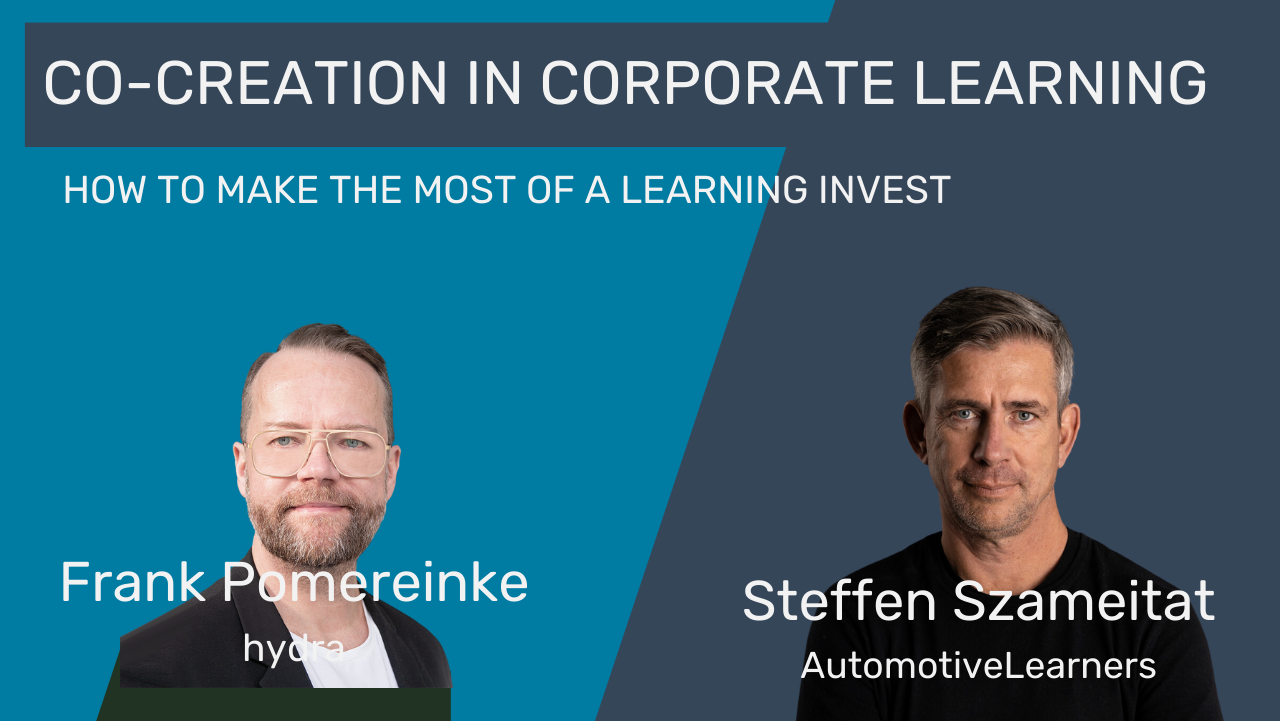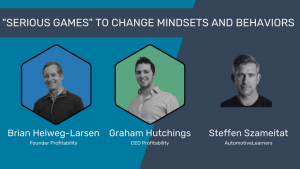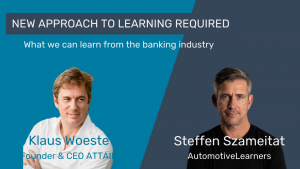Reading time: 9 minutes
Adult learning is slow. One reason for this is that recognized experts are often abysmal teachers. Expertise does not always guarantee didactic competence. Specialist knowledge is often valued more highly than the actual art of imparting knowledge.
Learning platforms that make knowledge available quickly, conveniently and cheaply also fall into this trap. Udemy, Coursera, or LinkedIn Learning market content, presenter reputation, and student ratings, not learning success.
This is obviously a problem: Studies show completion rates between 4% and 30%. Up to 70% of platform subscribers never take part in their course.
Most of the large companies I’ve spoken to use these platforms. They pay for the subscriptions, but the learning successes do not materialize as expected.
How can we bring the art of knowledge transfer into digital learning? I spoke to learning designer Frank Pomereinke, managing partner of hydra in Stuttgart.

Hi Frank. Let’s start at the beginning: What is your dream car?
If you grow up in Stuttgart, Böblingen or Sindelfingen, you are practically in the heart of the German automotive industry, with Daimler and Porsche as formative factors. However, my home was closer to Porsche because I lived near Weissach. The test track on which Walter Röhrl tested the legendary Porsche 911 is located there. After school, I sat in the bushes with my friends and chased the latest 911s around the test track.
And I’m also at the age where people say: “The 911 should now being added as a second car.”
But during the pandemic, my passion for camping intensified and since then I own a VW T3 camper van that is 40 years old. I use it to go camping with my kids whenever possible. My dream car is this bus because it allows for wonderful relaxation. If you drive a car at a speed of 40 km/h over the Brenner Pass to Lake Garda, you no longer have to worry about traffic jams and evening traffic, knowing that you will be on the road for another 10 hours.
This form of deceleration has an enormous healing effect.

2019 and 2022 were absolutely top years for the automotive industry. But the pandemic changed many things. The learning industry has been affected by hybrid work-from-home work. Where are we now?
Learning has become even more crucial for the competitiveness of companies
Knowledge is essential for product development, value creation, and strategy execution. It is important to keep this kind of competitiveness in Germany and Europe, as employees in these countries are the most important resource.
There is a lot of thought going on about future capabilities, the skills needed to manage the transformation from the industrial age to the network age. Companies need to prepare their employees for these challenges in the best possible way.
The question is: What are these skills and how can they be learned?
Please give us examples of Future Skills.
Digital skills and self-directed learning are two fundamental Future Skills. Digital skills are the effective use of tools such as Miro, Microsoft cloud applications, and communication platforms such as Slack and Teams.
Self-directed learning requires the ability to independently search for information and identify what knowledge is relevant to the job. What should we do with the numerous teaching catalogs from Udemy or LinkedIn if they are not relevant to users?
The keyword here is “Creator Economy meets Corporate Learning”. LinkedIn, YouTube, and Twitter also offer a large amount of relevant knowledge.
Yes, exactly, that’s the third future skill for me, namely networking and collaborative creation.
There are certainly people in the company who have solved similar problems and probably my problem before. How can I find this information and build a network? Then you should also document and pass on what you have learned: “We now understand how ChatGPT works, which is important for us now for our job, but maybe we should also describe it to our colleagues so that it is reproducible.”

In companies today, we have learning programs and training catalogs based on job profiles, assign content and delivered via a learning management system. Although it is well structured, it is also static.
I refer to this by the term “curriculum mentality”. And that has had its day today.
Today, it’s all about thoroughly understanding dynamic job roles. In daily life, they look completely different from the official job description.
For example, during a project where we developed a web-based training (WBT) for a premium manufacturer, we found that a typical car dealership had eight different job roles. And each of these roles has its own learning requirements and seeks different content in such a WBT.
With many different job roles, traditional training can’t achieve much. After all, learners don’t have much time and want to be efficient.
In order to be offered in a personalized way, the content must be modularized. The content must be built like Lego bricks and combined for specific job roles. In order to accurately understand the job roles and learning needs, the training must be developed with the target group.
Five years ago, just one hour of WBT was produced. This is no longer enough to reach today’s learners.
As learning designers, it is a challenge for us to adapt content to the different job profiles. We need to provide a compelling and meaningful learning experience. This requires connectivity and careful transitions.
However, this also means that the better the learner’s understanding, the better you can modularize and personalize, which in turn leads to a better outcome.
The involvement of learners is, in my view, the central point.
As learning designers, we focus on “co-creation”. And that’s the key to success.
In recent years, not only has the focus on the learner changed, but also other aspects. All stakeholders are also identified and integrated into the process. After all, top management and executives also have requirements they must meet. They also need to understand learning needs and be committed to learning. It also means creating degrees of freedom for learners.
That’s enormously exciting and if you were to ask me, Steffen, what my passion is?
To integrate this co-creation process into different learning environments and to develop learner-centered solutions. Most have understood what they need for their job, and they know that better than HR or SME.
And do you know what happens?
The employees are thrilled because they are finally being asked.
That’s right, they’re thrilled!
That’s pure motivation! They say to themselves, “Hey, finally someone is asking me.”
And that’s the second hidden building block in co-creation. And it’s not new. In the past, we had always emphasized that those affected should be involved. And we’re inventing a new version of it. Through this process, we not only get more structured and modularized, more targeted learning content, but also a new motivation for the learners.
We have implemented this in an exemplary manner with a pharmaceutical company. There, in a multi-stage, agile process, we brought the learners to the point where they ended up building their own prototypes of how they wanted to learn using SAP scenes. There were knowledge nuggets, ideal for short idle times, and a podcast with motivating voice contributions and so on. Really original stuff. We then tested them, evaluated them and then implemented the best ones.
You can imagine how engaged the learners were, like, “Hey, look at my idea, this was implemented.”
As a manager, if I ask an employee, “What do you want?” the answer may mean that I have to say, “Can’t we afford it?” What is your experience with this?
That hasn’t happened to us yet. This is because co-creation involves all relevant stakeholders at an early stage.
For example, in the first phase, relevant building blocks are identified and alternatives to conventional training courses and e-learning offers are developed. This is then coordinated with the managers.
In the next step, prototypes are created, tested and evaluated. This is done iteratively and allows adjustments to be made to the needs of all parties involved.
Something is new in co-creation: the function of managers is changed from “captain” to “enabler” in co-creation. To gain their trust in the creative process, they are involved from the very beginning. It is necessary precisely because the results are not yet fully predictable at the beginning, and we count on their support.
Before the modules are manufactured, the budget and resources are determined to develop solutions that meet their needs.
So, co-creation is a structured process that combines the company’s strategies, employee learning needs, and available resources. Co-created learning modules should bring a positive return on investment.
Yes. Because the potential lies not only in the digitalization and scaling of learning content, but also in many lesser-considered aspects that become evident through co-creation.
For example, a client wanted to make his pure seminar-based training courses for quality assurance, which were associated with high travel costs for the trainers, more efficient. Through the co-creation process, it became clear that the greatest leverage was with moderators. They act as a crucial link between learners and trainers. However, there were too few moderators, which was due to the poor training.
Through the co-creative process, we have reoriented ourselves from the digitalization of learning content to the targeted inclusion and optimization of facilitator training.
What is the importance of learning technology both today and in the future?
We are not technology-driven. However, as learning designers, we use technology to shape the outcome and experience of learning.
To do this, we need to understand all the available technologies and understand their advantages and disadvantages. We explain different learning formats within co-creation to our customers. We have an arsenal of 40 different learning formats at our disposal, and of course there is technology behind it. A learning format is the use of a specific learning strategy or technology. And the working conditions of the learners decide which formats are suitable.
Adapting a different devices and screen sizes is another technological aspect. Learning applications may need to be used on both desktop computers and smartphones. Since the development of high-quality, multi-device-compatible learning applications is costly, this requires careful technical planning.
It is important to understand the needs of users and conduct a cost-benefit analysis to decide whether the investment in multi-device capability is justified.
Another example for a customer: 80% of the content was perfected so that it could be viewed on iPads in the back office. At the same time, a “bring-your-own-device” policy was introduced, allowing employees to watch certain content on their own devices. We’ve only optimized short “cheat sheets” to use outside of the back office on personal devices. The mass of the training has only been perfected on iPads to be displayed in the back offices.
Another layer is the consideration of accessibility to ensure that employees with visual or hearing impairments can also experience multimedia content. This, too, requires investment.
The co-creation process provides answers to where companies should invest for effective employee learning.
That’s exactly what we offer our customers. This service is currently very successful on the market. We seem to have hit a nerve with this. This can also be scaled and adapted larger or smaller for customers with major strategic challenges or short-term projects.
To sum it up: We maximize the learning investment by completely pulling the motivation of the learners as an added lever.
Last week, I spoke with one of the world’s top leadership trainers. His recipe for success so far: clear instructions and monitoring of the implementation. I showed him our co-creation service and he loved it.
Perhaps you would like to say something about hydra.
With pleasure: hydra has been around for almost two decades. Our origins lie in the field of digital marketing, and we have proved ourselves at all German manufacturers and suppliers in e-learning and web-based training (WBT). It may also be due to our origins in Stuttgart. Our focus is on the automotive industry, and we have an excellent position for this in Swabia.
The user experience has always been at the forefront and our WBTs have been an excellent learning experience from the very beginning. Co-creation has become an important part of Hydra since the pandemic and the rise of digital learning. Our team consists of 30 specialists who produce everything in-house to create engaging learning experiences.


